2.1 Starting with a Big Bang
According to the Big Bang Theory, the universe blinked violently into existence 13.77 billion years ago (Figure 2.1). The big bang is often described as an explosion, but imagining it as an enormous fireball isn’t accurate. The big bang involved a sudden expansion of matter, energy, and space from a single point. The kind of Hollywood explosion that might come to mind involves expansion of matter and energy within space, but during the big bang, space itself was created.

At the start of the big bang, the universe was too hot and dense to be anything but a sizzle of particles smaller than atoms, but as it expanded, it also cooled. Eventually some of the particles collided and stuck together. Those collisions produced hydrogen and helium, the most common elements in the universe, along with a small amount of lithium.
You may wonder how a universe can be created out of nothing, or how we can know that the big bang happened at all. Creating a universe out of nothing is mostly beyond the scope of this chapter, but there is a way to think about it. The particles that make up the universe have opposites that cancel each other out, similar to the way that we can add the numbers 1 and −1 to get zero (also known as “nothing”). As far as the math goes, having zero is exactly the same as having a 1 and a −1. It is also exactly the same as having a 2 and a −2, a 3 and a −3, two −1s and a 2, and so on. In other words, nothing is really the potential for something if you divide it into its opposite parts. As for how we can know that the big bang happened at all, there are very good reasons to accept that it is indeed how our universe came to be.
Looking back to the early stages of the big bang
The notion of seeing the past is often used metaphorically when we talk about ancient events, but in this case it is meant literally. In our everyday experience, when we watch an event take place, we perceive that we are watching it as it unfolds in real time. In fact, this isn’t true. To see the event, light from that event must travel to our eyes. Light travels very rapidly, but it does not travel instantly. If we were watching a digital clock 1 m away from us change from 11:59 a.m. to 12:00 p.m., we would actually see it turn to 12:00 p.m. three billionths of a second after it happened. This isn’t enough of a delay to cause us to be late for an appointment, but the universe is a very big place, and the “digital clock” in question is often much, much farther away. In fact, the universe is so big that it is convenient to describe distances in terms of light years, or the distance light travels in one year. What this means is that light from distant objects takes so long to get to us that we see those objects as they were at some considerable time in the past. For example, the star Proxima Centauri is 4.24 light years from the sun. If you viewed Proxima Centauri from Earth on January 1, 2015, you would actually see it as it appeared in early October 2010.
We now have tools that are powerful enough to look deep into space and see the arrival of light from early in the universe’s history. Astronomers can detect light from approximately 375,000 years after the big bang is thought to have occurred. Physicists tell us that if the big bang happened, then particles within the universe would still be very close together at this time. They would be so close that light wouldn’t be able to travel far without bumping into another particle and getting scattered in another direction. The effect would be to fill the sky with glowing fog, the “afterglow” from the formation of the universe (Figure 2.1).
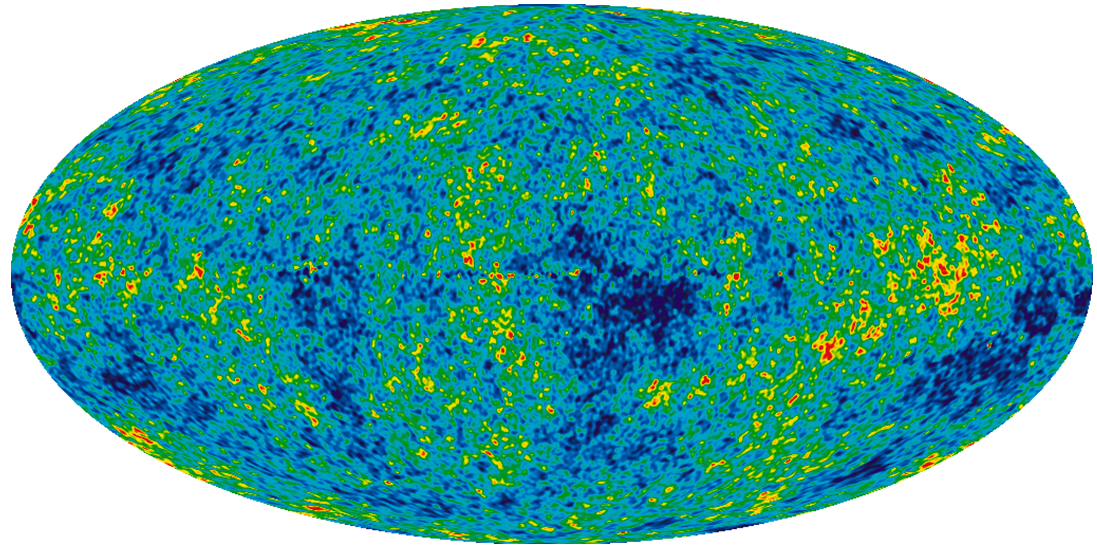
In fact, this is exactly what we see when we look at light from 375,000 years after the big bang. The fog is referred to as the cosmic microwave background (or CMB), and it has been carefully mapped throughout the sky (Figure 2.2). The map displays the cosmic radiation left over from the an early stage in the development of the universe at the time when protons and neutrons were recombining to form atoms</code>microwave background as temperature variations, but these variations translate to differences in the density of matter in the early universe. The red patches are the highest density regions and the blue patches are the lowest density. Higher density regions represent the eventual beginnings of stars and planets. The map in Figure 2.2 has been likened to a baby picture of the universe.
The big bang is still happening, and we can see the universe expanding
The expansion that started with the big bang never stopped. It continues today, and we can see it happening by observing that large clusters of billions of stars, called galaxies, are moving away from us. (The exception is the Andromeda galaxy with which we are on a collision course.) The astronomer Edwin Hubble came to this conclusion when he observed that the light from other galaxies was red-shifted. The red shift is a consequence of the Doppler effect. This refers to how we see waves when the object that is creating the waves is moving toward us or away from us.
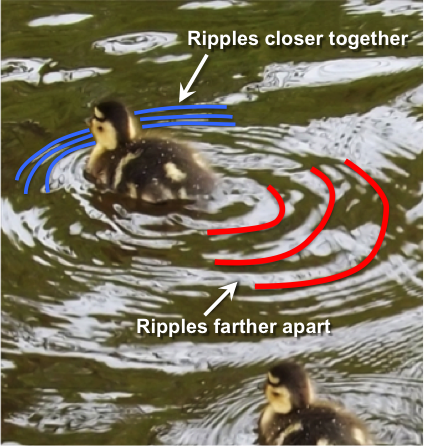
Before we get to the Doppler effect as it pertains to the red shift, let’s see how it works on something more tangible. The duckling swimming in Figure 2.3 is generating waves as it moves through the water. It is generating waves that move forward as well as back, but notice that the ripples ahead of the duckling are closer to each other than the ripples behind the duckling. The distance from one ripple to the next is called the wavelength. The wavelength is shorter in the direction that the duckling is moving, and longer as the duckling moves away.
When waves are in air as sound waves rather than in water as ripples, the different wavelengths manifest as sounds with different pitches—the short wavelengths have a higher pitch, and the long wavelengths have a lower pitch. This is why the pitch of a car’s engine changes as the car races past you.
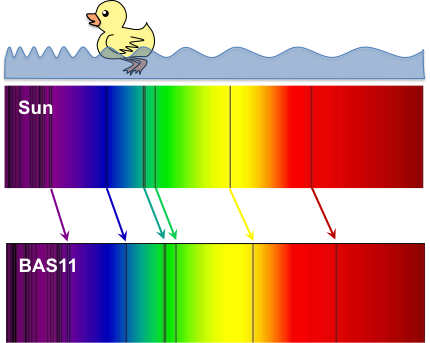
For light waves, wavelength translates to color (Figure 2.4). In the spectrum of light that we can see, shorter wavelengths are on the blue end of the spectrum, and longer wavelengths are on the red end of the spectrum. Does this mean that galaxies look red because they are moving away from us? No, but the color we see is shifted toward the red end of the spectrum and longer wavelengths.
Notice that the sun’s spectrum in the upper part of Figure 2.4 has some black lines in it. The black lines are there because some colors are missing in the light we get from the Sun. Different elements absorb light of specific wavelengths, and many of the black lines in Figure 2.4 represent colors that are absorbed by hydrogen and helium within the Sun. This means the black lines are like a bar code that can tell us what a star is made of. The lower spectrum in Figure 2.4 is the light coming from BAS11, an enormous cluster of approximately 10,000 galaxies located 1 billion light years away. The black lines represent the same elements as in the Sun’s spectrum, but they are shifted to the right toward the red end of the spectrum because BAS11 is moving away from us as the universe continues to expand. So to summarize, because almost all of the galaxies we can see have light that is red-shifted, it means they are all moving away from us. In fact, the farther away they are, the faster they are going. This is evidence that the universe is still expanding.
Video: Earth Rocks – Earth Formation
Media Attributions
- Figure 2.1: “Time Line of the Universe” by NASA and WMAP Science Team. Adapted by Karla Panchuk. Public domain.
- Figure 2.2: “Nine Year Microwave Sky” by NASA/ WMAP Science Team. Public domain.
- Figure 2.3: “Duck and Ducklings” by M. Harkin. Adapted by Karla Panchuk. CC BY.
- Figure 2.4: “Spectra” by Harold Stokes. Adapted by Karla Panchuk. Public domain.
Licenses and Attributions
“Physical Geology – 2nd Edition” by Steven Earle (Chapter 22 is written by Karla Panchuk) is licensed under CC BY 4.0 Adaptation: Renumbering, Remixing
the theory that the universe started with a giant explosion approximately 13.77 billion years ago
the distance that light can travel in one year (9.4607 × 1012 km)
radiation left over from the an early stage in the development of the universe at the time when protons and neutrons were recombining to form atoms
a gravitationally-bound system of stars and interstellar matter
the increase in wavelength of light resulting from the fact that the source of the light is moving away from the observer
Bands of earthquakes trace out plate boundaries (colored dots, Figure 12.16). The depths of earthquakes, and the width of the band, depend on the type of plate boundary. Mid-ocean ridges and transform margins have shallow earthquakes (usually less than 30 km deep), in narrow bands close to plate margins. Subduction zones have earthquakes at a range of depths, including some more than 700 km deep. Bands of earthquakes are wider along subduction zones because they take place throughout the subducting slab that extends beneath the opposing plate. Wide swaths of scattered earthquakes may correspond to continent-continent collision zones, such as between the Eurasian plate and the African, Arabian, and Indian plates to the south. Wide swaths of scattered earthquakes may also correspond to continental rift zones, such as in eastern Africa.
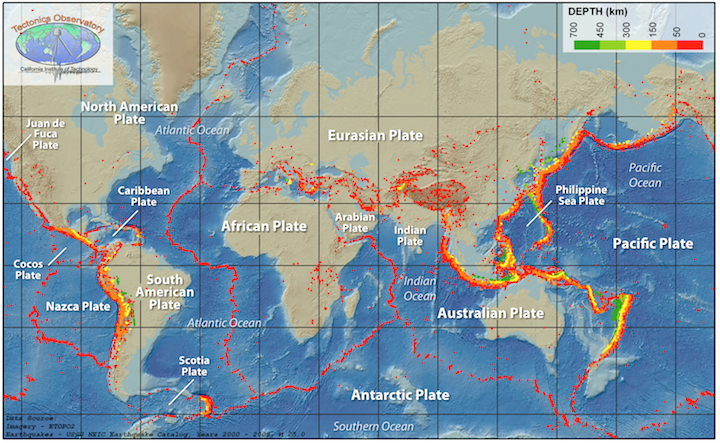
Earthquakes are also relatively common at a few locations away from plate boundaries. Some are related to the buildup of stress due to continental rifting or the transfer of stress from other regions, and some are not well understood. Locations include the Great Rift Valley area of Africa, the Lake Baikal area of Russia, and Tibet.
Earthquakes at Divergent and Transform Plate Boundaries
Earthquakes along divergent and transform plate margins are shallow (usually less than 30 km deep) because below those depths, rock is too hot and weak to avoid being permanently deformed by the stresses in those settings. If deformation is permanent, then removing the stress does not result in the rocks snapping back to their original shape. No snapping back means no shaking.
Mid-ocean ridge divergent plate margins are offset by numerous transform faults (Figure 12.17). The locations of earthquakes along mid-ocean ridges, and the mechanisms for causing them, depend on how rapidly the mid-ocean ridges are spreading. The Pacific-Antarctic Ridge (left) is spreading relatively rapidly at 42 to 94 mm/year, depending on the location along the ridge. Rapid spreading causes rocks near the axis of the spreading center to be hot and weak. As a result, most of the earthquakes (white dots) are located along transform faults, where rocks are cooler and stronger. Along rapidly spreading ridges, new ocean crust is bent upward into wide, high ridges. As spreading proceeds and crust moves away from the ridge, the bend is relaxed, and the crust stretches and breaks. This triggers earthquakes many kilometers away from the ridge.
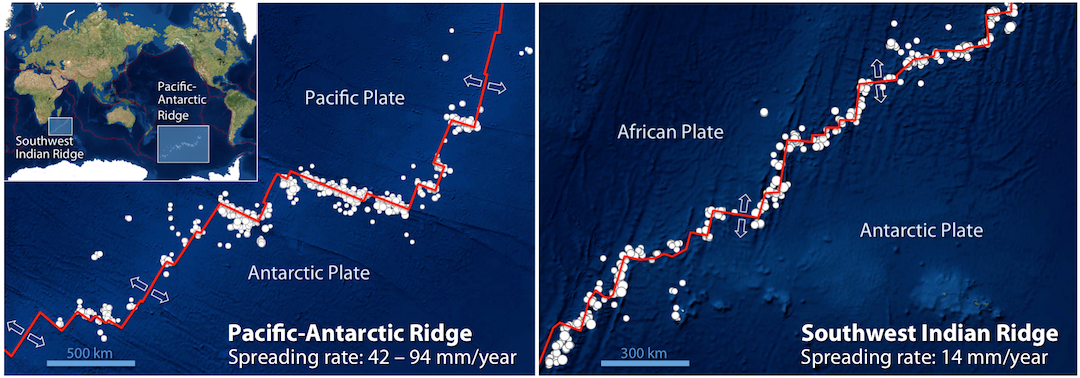
The Southwest Indian Ridge (right) spreads very slowly, at approximately 14 mm/year. Rocks are cooler and stronger along the slowly spreading ridge than along the rapidly spreading one. In the slow-spreading environment, earthquakes are generated when rocks along the ridge axis stretch and break. Earthquakes are more evenly distributed between divergent and transform segments of the boundary than they are along fast-spreading ridges.
Earthquakes in continental rift zones are also shallow, but scattered more broadly than those along mid-ocean ridges. Lake Baikal (Figure 12.28), the world's oldest, deepest, and largest freshwater lake, formed 25 million years ago because of continental rifting. Note the scale in Figure 12.18, and compare how widely the earthquakes (blue dots) are spread in the Lake Baikal region, versus along the mid-ocean ridges in Figure 12.17.
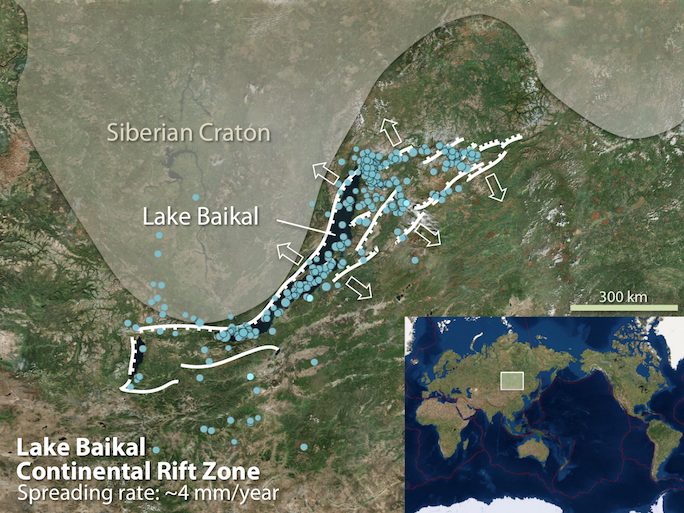
One reason for the difference in earthquake distribution in continental rift zones is that the rifts are only beginning to form. Faulting is "disorganized" within the continental crust. There is no well-established spreading center, unlike mid-ocean ridges. Another reason is that the locations of faults, and thus earthquakes, in continental rift zones are affected by pre-existing geological structures within continental crust. In the case of the Lake Baikal rift, the strong, ancient crust of the Siberian Craton influences the orientation of the faults forming the rift. Faults run parallel to the craton near Lake Baikal. As rifting extends to the east, the part of the craton in the upper right of Figure 12.18 may deflect rifting southward.
Earthquakes at Convergent Boundaries
Subduction Zones
Along convergent plate margins with subduction zones, earthquakes range from shallow to depths of up to 700 km. Earthquakes occur where the two plates are in contact, as well as in zones of deformation on the overriding plate, and along the subducting slab deeper within the mantle. The result is that epicenters of earthquakes farther to the interior of the overriding plate will correspond to increasingly deep earthquakes.
Where the Pacific plate subducts beneath the North American plate, forming the Aleutian volcanic arc (Figure 12.19), earthquakes increase in depth moving northward, following the Pacific plate into the mantle. Earthquakes between 0 and 33 km deep (red circles) occur closest to the subduction zone (red line; teeth point in the direction of the subducting slab). While there is some overlap, earthquakes between 33 and 70 km deep (white circles) occur in a band that reaches farther the north. Farthest north are the epicenters for earthquakes between 70 and 300 km deep (green dots). The deepest earthquake during the seven year interval shown in Figure 12.19 is represented by the large green dot farthest to the north. It occurred at a depth of 265 km.
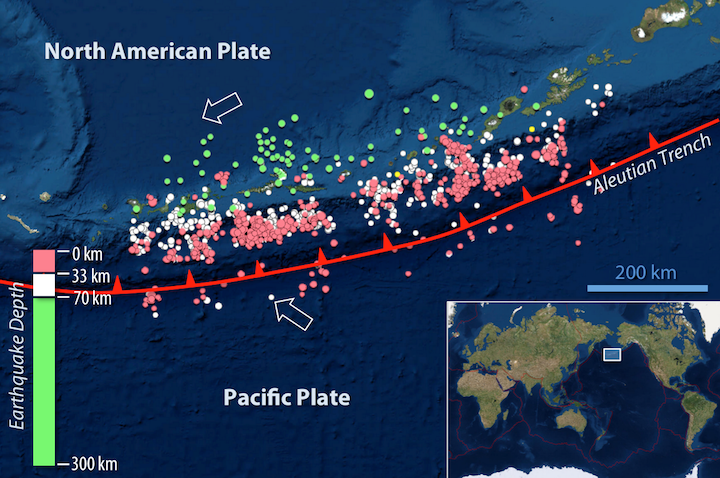
Earthquakes occur in subduction zones for a variety of reasons. Stresses associated with the collision of two plates cause deformation in the overriding plate, and thus shallow earthquakes. Shallow earthquakes also happen on the subducting slab when a locked zone (orange line, Figure 12.20) ruptures. The locked zone is where the largest earthquakes on Earth, called megathrust earthquakes, occur. There is the potential for a wider rupture zone on a gently dipping subduction zone boundary compared to other boundaries.
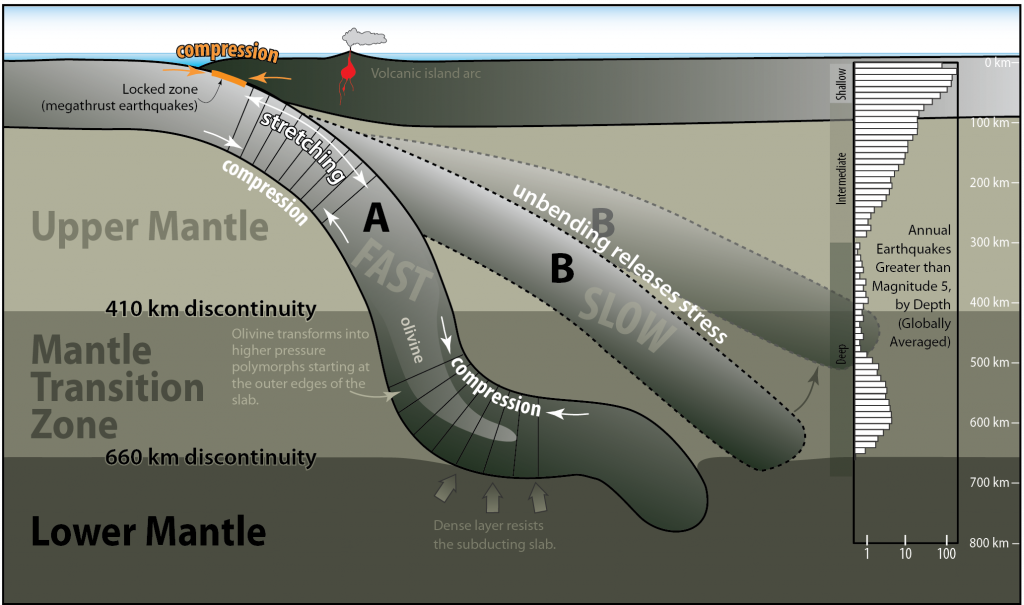
If subduction is rapid, the subducting plate will bend more as it enters the mantle (slab A in Figure 12.20), causing the upper edge of the plate to stretch, and the interior and lower edge to be compressed. Stress from bending can cause shallow to intermediate earthquakes on these plates. Even without bending, the subducting slab can become stretched by its own weight as it falls into the mantle.
The 410 km and 660 km discontinuities in Figure 12.20 mark boundaries where minerals transform into other, denser minerals that are stable at higher pressures and temperatures. When the subducting slab reaches the 660 km discontinuity (the top of the lower mantle), the increase in density in the surrounding mantle may slow down the leading edge of the sinking slab. Earthquakes can be generated when the slab is compressed by the lower mantle resisting its motion at the same time that the upper part of the slab continues to fall.
Slower rates of subduction mean that the subducting slab will enter the mantle at a lower angle (slab B in Figure 12.20). These slabs might not have earthquakes from being bent downward into the mantle, as with slab A, but earthquakes may be triggered by changes in stress if the plate relaxes and unbends.
The bar chart on the right of Figure 12.20 shows global average number of earthquakes that occur at different depths. Earthquakes are most abundant at the surface, and then fall to a minimum at 300 km. The number of earthquakes remains low until almost 500 km depth, and reaches a second peak around 600 km depth. The second peak might be explained by interactions between the subducting plate and the dense mantle beneath the 660 km discontinuity, but another hypothesis is that it is related to delayed mineral transformations. The subducting slab warms as it goes deeper into the mantle, but the warming is not uniform. The outer edges of the slab will warm before the interior does. The 410 km discontinuity is where olivine is transformed into the minerals wadsleyite and ringwoodite under normal mantle pressure and temperature conditions. However, if the interior of the subducting slab is still too cool at that depth, olivine will be retained to depths below 410 km. Olivine weakens prior to transforming into the high pressure minerals, and the weakening may make it easier for the slab to rupture.
Continent-Continent Convergence Zones
Where continents collide, earthquakes are scattered over a much wider area compared to earthquakes along mid-ocean ridges, transform margins, or subduction zones. An example is where the Indian plate collides with the Eurasian plate (Figure 12.21). At one time, India was a separate continent, and ocean crust separated India from the Eurasian plate. For a time, a subduction zone existed where ocean lithosphere from the Indian plate subducted beneath the Eurasian plate. But when the two land masses finally met, they became locked together and the subduction zone was closed off. Today the Indian plate is still pushing against the Eurasian plate in the regions indicated by the red arrows in Figure 12.21. The collision is accommodated by transform boundaries along the Indian plate. Regions of overall transform motion are indicated in Figure 12.21 with blue arrows.
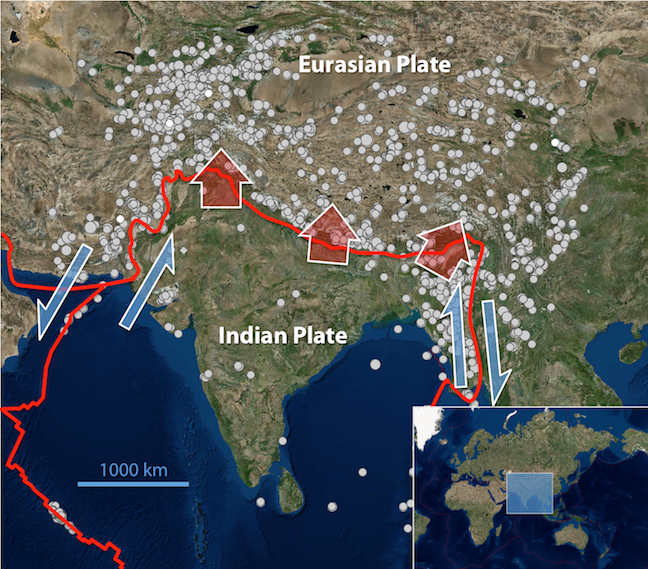
The majority of earthquakes in Figure 12.21 occur at depths less than 70 km, however they are still abundant down to 150 km, and extend to more than 300 km depth at some locations. Deeper earthquakes may be caused by continued northwestward subduction of part of the Indian plate beneath the Eurasian plate in this area. Even though the area is no longer a subduction zone, the subducted slab still remains, and is subject to stresses that can trigger earthquakes.
Some of the earthquakes in Figure 12.21 are related to the transform faults on either side of the Indian plate, and most of the others are related to the squeezing caused by the continued convergence of the Indian and Eurasian plates. That squeezing has caused the Eurasian plate to be thrust over the Indian plate, building the Himalayas and the Tibet Plateau to enormous heights. Most of the earthquakes of Figure 12.21 are related to the thrust faults shown in Figure 12.22 (and to hundreds of other similar ones that cannot be shown at this scale). The southernmost thrust fault in Figure 12.22 (the Main Boundary Fault) is equivalent to the convergent boundary in Figure 12.21.
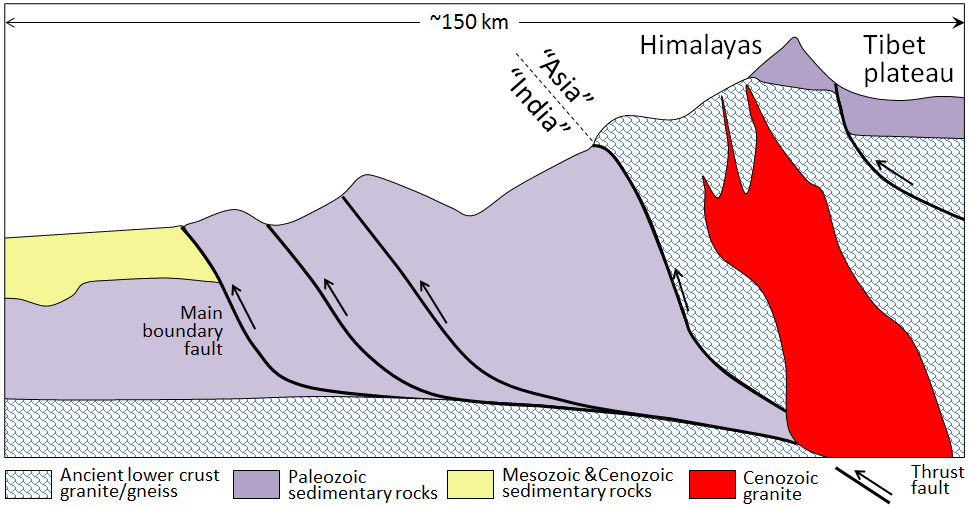
Intraplate Earthquakes
Intraplate earthquakes (within-plate earthquakes) are those that occur away from plate boundaries. Some intraplate earthquakes are related to human activities. When humans trigger earthquakes it is referred to as induced seismicity. In Saskatchewan there have been 20 earthquakes since 1985 (all less than magnitude 4), and the majority occurred near potash mines. Excavation changes the stress in surrounding rocks, so earthquakes may occur in the rocks above excavated parts of the mine. In Alberta, induced seismicity is triggered by hydraulic fracturing operations when water pressure increases along existing faults, causing them to slip.
Intraplate earthquakes not related to human activities often occur along ancient rift zones. In eastern Canada, the Charlevoix seismic zone (approximately 100 km northeast of Québec City; Figure 12.23), is associated with a rift-zone faults that developed when an ancient ocean basin began to form more than 500 million years ago. Coincidentally, the rocks of the Charlevoix Seismic Zone are also fragmented because of a meteorite impact (the crater margin is indicated by the blue circle in Figure 12.23), weakening them further. While the Charlevoix zone is far from any boundary of the North American plate, tectonic forces acting on plate boundaries are still transmitted to the interior of the continent, contributing to the stress that causes the faults along the rift zone to rupture.
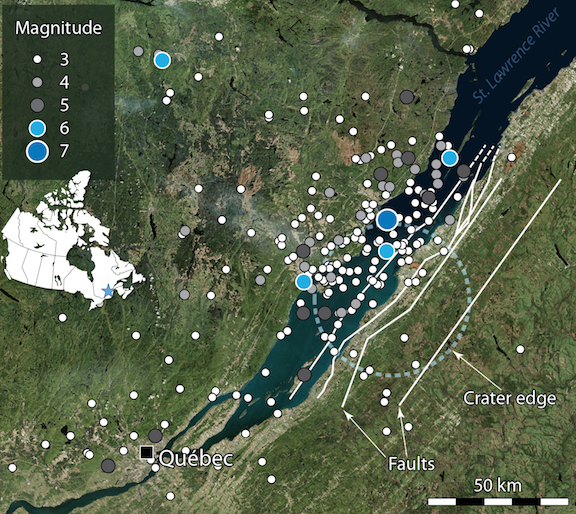
Intraplate earthquakes can be large earthquakes. The Charlevoix seismic zone has had five earthquakes of magnitudes between 6 and 7 since 1663. The New Madrid seismic zone in the Mississippi River Valley had a series of four earthquakes with magnitudes between 7 and 8 in the winter of 1811-1812. The population of the region was sparse at the time, but today there are major cities in the New Madrid seismic zone, including Memphis, Tennessee, and St. Louis, Missouri.
References
Buck, W. R., Lavier, L. L., & Poliakov, A. N. B. (2005). Modes of faulting at mid-ocean ridges. Nature 434(7034), 719-23. doi: 10.1038/nature03358
Coastal and Marine Geology Program, U. S. Geological Survey (n.d.). Lake Baikal - A Touchstone for Global Change and Rift Studies. Visit website
DeMets, C., Gordon, R. G., & Argus, D. F. (2010). Geologically current plate motions. Geophysical Journal International 181, 1-80. doi: 10.1111/j.1365-246X.2009.04491.x
Earthquakes Canada, Natural Resources Canada (2016) Earthquake zones in Eastern Canada Visit website
Sloan, R. A., Jackson, J. A., McKenzie, D., & Priestley, K. (2011). Earthquake depth distributions in central Asia, and their relations with lithosphere thickness, shortening and extension. Geophysics Journal International 185, 1-29. doi: 10.1111/j.1365-246X.2010.04882.x
Licenses and Attributions
"Physical Geology, First University of Saskatchewan Edition" by Karla Panchuk is licensed under CC BY-NC-SA 4.0 Adaptation: Renumbering, Remixing

